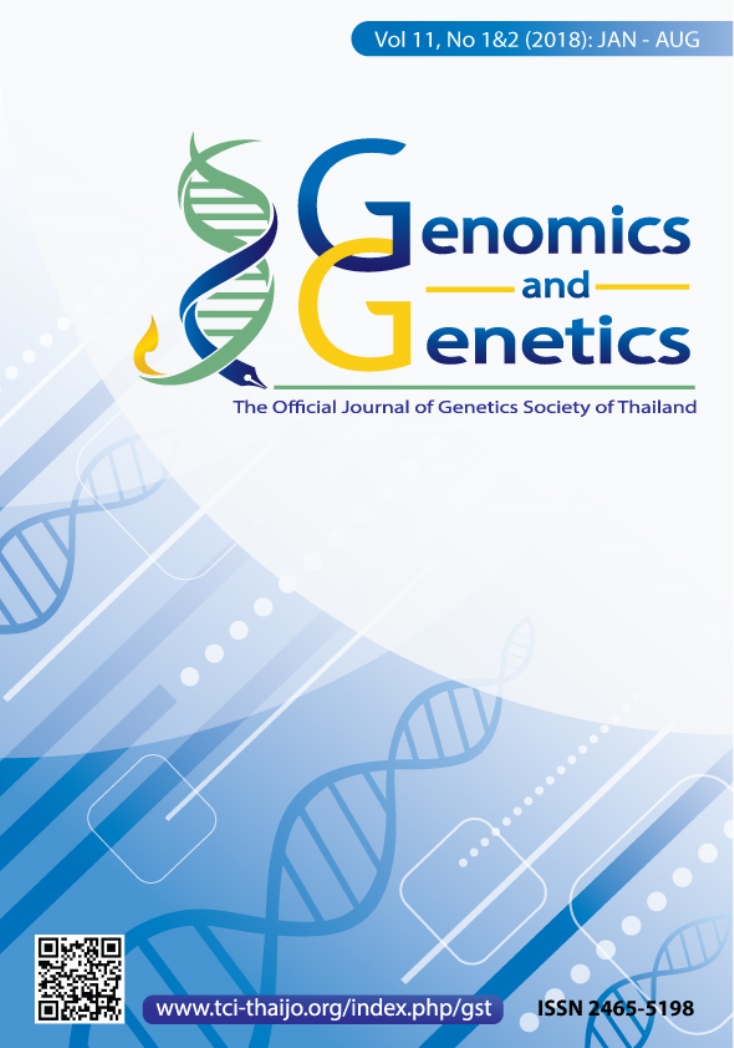Assessing genetic diversity of some Anthurium andraeanum Hort. cut-flower cultivars using ISSR markers
DOI:
https://doi.org/10.14456/gag.2018.1Keywords:
Anthurium; genetic diversity; DNA markers; DNA fingerprint, ISSRAbstract
Anthurium andraeanum Hort. cultivars are an important ornamental plant with a very high genetic diversity. Most cultivars are characterized only based on the phenotype of inflorescence which are difficult to distinguished between very closely related cultivars. This research aims to assess the genetic diversity of 26 Anthurium cultivars using inter simple sequence repeat (ISSR) markers. The ten ISSR primers generated 122 total bands and 113 polymorphic bands with an average percentage of polymorphism of 91.64%. The average polymorphism information content (PIC) was 0.26, the average effective multiplex ratio (EMR) was 10.54, the average marker index (MI) was 2.84 and the average resolving power (Rp) was 11.32. Genetic similarity matrix from Pearson coefficient between the cultivars ranged from 0.01 between Joa Sua and Cherry Pink to 0.87 between Red Bar and Sun Red, with a mean of 0.58. Cluster analysis using the unweighted pair group method with arithmetic mean analysis (UPGMA) divided 26 cultivars into two major groups. The first group comprised only Thai native foliage anthurium while the second group included all cut-flower cultivars. Although the close relate between different appearance cultivar was found. These clustering was acceptable with Cophenetic Correlation Coefficient (CCC) was 0.92. The results obtained from this study can be useful for cultivar identification and genetic diversity assessment of Anthurium.
References
Basahi M (2015) ISSR-based analysis of genetic diversity among sorghum landraces growing in some parts of Saudi Arabia and Yemen. C R Biol 338: 723–727.
Bornet B, Branchard M (2001) Nonanchored inter simple sequence repeat (ISSR) markers: reproducible and specific tools for genome fingerprinting. Plant Mol Biol Rep 19: 209–215.
Chesnokov YV, Artemyeva AM (2015) Evaluation of the measure of polymorphism information of genetic diversity. Agricultural Biology 50: 571-578.
De Riek J, Calsyn E, Everaert I, Van Bockstaele E, De Loose M (2001) AFLP based alternatives for the assessment of distinctness, uniformity and stability of sugar beet varieties. Theor Appl Genet 103: 1254–1265.
Doyle JJ, Doyle JE (1990) Isolation of plant DNA from fresh tissue. Focus 12: 13–15.
Garcia-Vallvé S, Palau J, Romeu A (1999) Horizontal gene transfer in glycosyl hydrolases inferred from codon usage in Escherichia coli and Bacillus subtilis. Mol Biol Evol 16: 1125–1134.
Gilbert JE, Lewis RV, Wilkinson MJ, Caligari PDS (1999) Developing an appropriate strategy to assess genetic variability in plant germplasm collections. Theor Appl Genet 98: 1125–1131.
Guo ZH, Fu KX, Zhang XQ, Bai SQ, Fan Y, Peng Y, Huang LK, Yan YH, Liu W, Ma X (2014) Molecular insights into the genetic diversity of Hemarthria compressa germplasm collections native to southwest China. Molecules 19: 21541–21559.
Kalpana D, Choi SH, Choi TK, Senthil K, Lee YS (2012) Assessment of genetic diversity among varieties of mulberry using RAPD and ISSR fingerprinting. Sci Hortic 134: 79–87.
Najaphy A, Parchin RA, Farshadfar E (2011) Evaluation of genetic diversity in wheat cultivars and breeding lines using inter simple sequence repeat markers. Biotechnol Biotechnol Equip 25: 2634–2638.
Nowbuth P, Khittoo G, Bahorun T, Venkatasamy S (2005) Assessing genetic diversity of some Anthurium andraeanum Hort. cut-flower cultivars using RAPD markers. Afr J Biotechnol 4: 1189–1194.
Page RD (1996) TreeView: An application to display phylogenetic trees on personal computers. Comput Appl Biosci 12: 357–8.
Prevost A, Wilkinson MJ (1999) A new system of comparing PCR primers applied to ISSR fingerprinting of potato cultivars. Theor Appl Genet 98: 107–112.
Rashidi M, Farshadfar M, Safari H, Shirvani H (2013) Utility of ISSR molecule marker in examine of genetic diversity 17 genotypes of perennial alfalfa (Medicago sativa). J Nov Appl Sci 2: 969-973.
Salimath SS, de Oliveira AC, Godwin ID, Bennetzen JL (1995) Assessment of genome origins and genetic diversity in the genus Eleusine with DNA markers. Genome 38: 757–763.
Souza CPF, Ferreira CF, Souza EH, Neto ARS, Marconcinic JM, Ledo CAS, Souza FVD (2017) Genetic diversity and ISSR marker association with the quality of pineapple fiber for use in industry. Ind Crops Prod 104: 263–268.
Souza Neto JD, Soares TCB2, Motta LB, Cabral PDS, Silva JA (2014) Access to Anthurium genotypes diversity using SPAR markers. Genet Mol Res 13: 4766–4775.
Srisamoot N, Sootsuwan K (2016) Screening for bacterial blight resistance molecular marker of Anthurium andreanum. RMUTSV Research Journal 8: 102–111.
Srivastava PP, Vijayan K, Aswathi AK, Saratchandra B (2004) Genetic analysis of Morus alba through RAPD and ISSR markers. Ind J Biotechnol 3: 527–532.
Stancato GC, Tucci MLS (2010) Monitoring the end of the in vitro phase of Anthurium andreanum Lindl. plantlets. Braz J Plant Physiol 22: 61–68.
Tabin S, Kamili AN, Ganie SA, Zargar O, Sharma V, Gupta RC (2016) Genetic diversity and population structure of Rheum species in Kashmir Himalaya based on ISSR markers. Flora 223: 121–128.
Zhao L, Liu H, Cai G, Xia M (2014) Assessment of the genetic diversity and genetic relationships of Lilium in China using ISSR markers. Biochem Syst Ecol 55: 184–189.



